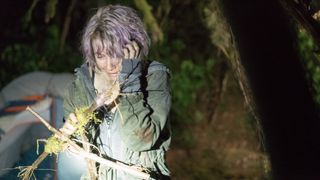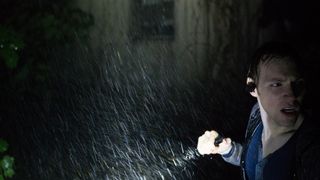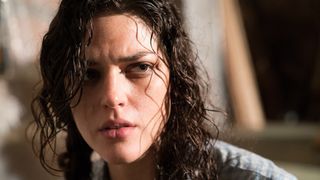5 ways to make a terrifying sequel - Blair Witch director explains

Remember how afraid you were back in 1998 when you saw The Blair Witch Project for the first time? So does new Blair Witch director Adam Wingard. In an exclusive interview in the brand new issue of our sister magazine, Total Film (out today!), Wingard outlines the exact horrifying steps he had to take to deliver the ultimate scary movie sequel 18 years on.
1. Maintain surprise
Shot as The Woods, the shock announcement that this was actually a Blair Witch movie only came at Comic Con…
“Early on, it did leak, but nobody believed it, and we just didn’t say anything. So from our end, keeping it secret was just never confirming nor denying it! I remember two days before the screening at Comic-Con, thinking to myself, ‘Oh wow, we actually did it!’ On set, only the people around the scenes – you know, where they would have actually heard the characters saying “Blair Witch” – knew. Everybody else had fake drafts. At [distributor] Lionsgate too, it was the same. Only the executives directly in charge knew about it. We never did public test screenings. We did internal screenings at Lionsgate with interns, and they all had to sign NDAs.”

2. Make a true sequel
In 2000, Book Of Shadows: Blair Witch 2 dumped the found footage angle and offered a post-modern slant. It flopped.
“I was really disappointed by the sequel and the direction they took. This is a continuation of the first movie. I’m coming at this whole thing as a fan of that original movie. This is a movie about Heather’s actual brother searching for her, so there’s a direct correlation. We’re reviving [the franchise] in a similar way that The Force Awakens treated the original Star Wars – it’s a whole new story, in the same spirit. The first film takes place in 1994. This is 20 years later. Heather’s brother was just a few years old when she went missing. Now he’s in college.”

3. Freshen the footage
The Blair Witch Project unleashed a deluge of found-footage horrors. Can the original’s impact ever be replicated?
“Absolutely. We really immerse you in the POV experience. For us, it was like: how do you take that found-footage angle to the next level? It’s an evolution of the subgenre. The biggest problem found footage always has is that everybody gets hung up on just using crappy cameras and thinking about it in terms of bad documentary filmmaking. But technology is at the point right now where these cameras almost look like the pro cameras. You can get away with a much more cinematic look. This is about bridging the gap between documentary found-footage style and dramatic horror and trying to make that all one experience.”
Sign up to the GamesRadar+ Newsletter
Weekly digests, tales from the communities you love, and more

4. Scare your actors
The original’s cast slept in the woods and were genuinely tormented by the filmmakers. Wingard also employed tricks…
“We weren’t able to just throw the actors out there and have them exist in the forest in the same way, but we did want them legitimately scared. For instance, there’s a sequence at the end where Callie Hernandez crawls through this 50ft tunnel. She’s actually jammed up in there. There’s no way to get out. That kind of fear reads on screen. The other thing I did – and this is my big trade secret – is that I had this collection of air horns. They never knew when it was coming. We’d be doing a scene and I’d just give it a blast. They called them my ‘scare horns’.”

5. Love the original
Book of Shadows annoyed fans by showing so little respect for what made the original so special. Not this time…
"The Guest and You’re Next represent what got me interested in film. I’ve been on this nostalgia kick, and this is just another element of that. I saw The Blair Witch Project right when it came out in ’99. I was in my last years of high school, and I immediately made a Blair Witch parody with my friends in my backyard. So, for me, Blair Witch was absolutely the hardest film I’ve ever made. I felt like I was going to have a nervous breakdown – I had so much to live up to, because the original is one of the best horror films of all time. The internal test screenings were a shot in the arm because people were scared shitless.”
For more previews, news, and features, check out the new issue of Total Film magazine out today or subscribe to future issues here.

The Total Film team are made up of the finest minds in all of film journalism. They are: Editor Jane Crowther, Deputy Editor Matt Maytum, Reviews Ed Matthew Leyland, News Editor Jordan Farley, and Online Editor Emily Murray. Expect exclusive news, reviews, features, and more from the team behind the smarter movie magazine.
Most Popular


